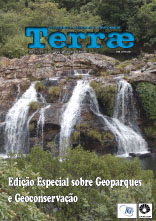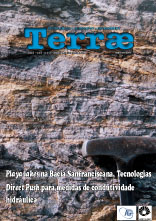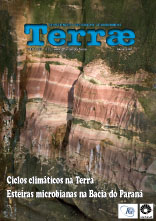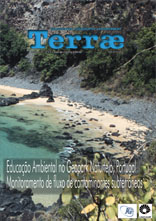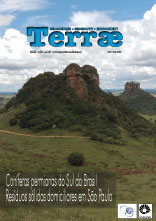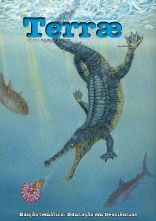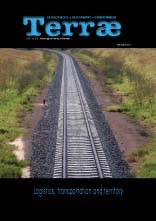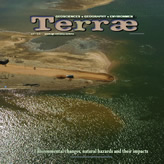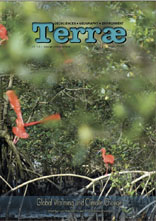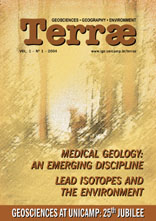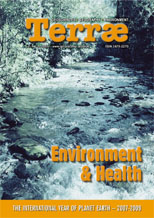Save the date / Call for papers
A revista Terræ publica simultaneamente as edições online de 2016 e 2017. As edições impressas acham-se temporariamente suspensas, pois os editores reconhecem que a internet oferece formas mais eficazes para disseminar rapidamente os resultados das pesquisas. As reformulações do periódico objetivam ampliar a abrangência, combinando redução de custos com rapidez de publicação. Cada vez mais a revista consolida a tendência de cobrir temas multidisciplinares que revelem formas de interação das Geociências com as diferentes áreas do conhecimento humano. A edição de Terræ 2017 é inteiramente dedicada ao tema GEOPARQUES.
A revista aceita trabalhos e comunicações em Português, Inglês e Espanhol.
Chamada de trabalhos / CALL FOR PAPERS
Uma vez recuperado o tempo de ausência na web, a edição de Terræ 2018 tornar-se-á uma boa opção para publicação de artigos científicos. O volume deverá reunir contribuições referentes a GEOÉTICA, tema que permite acomodar abordagens diferenciadas que revelem as inter-relações entre a sociedade e os ecossistemas terrestres.
O sistema de submissão e avaliação de artigos científicos está em pleno funcionamento, sendo feito exclusivamente pelo E-mail: terrae@ige.unicamp.br. Nosso sítio web está à sua disposição.
Esperamos sua visita e participação!
Os editores.
10/01/2018- 16:31 pm
Chamada de trabalhos/ Call for papers para o Volume 15, 2018
Novas contribuições são aceitas para o volume 2018 de Terræ.
Data limite 30.abril.2018
10/01/2018- 16:31 pm
Chamada de trabalhos/ Call for papers para os eventos:
VIII GeoSciEd 2018 – the 8th Quadrennial Conference of the
International Geoscience Education Organisation (IGEO)
– Geosciences for Everyone –
VIII Simpósio Nacional de Ensino e História de
Ciências da Terra / EnsinoGEO-2018
– Geociências para Todos –
Campinas – Sao Paulo – Brazil, July 2018
Acesse o site: http://www.ige.unicamp.br/geoscied2018/en/.
Data limite 11.fevereiro.2018
11/01/2018- 13:40 pm
Livro "Geologia do Brasil”, 2012: Reserve já seu exemplar, sem despesas de remessa.
Visite o endereço eletrônico: www.editorabeca.com.br
Os editores
Campinas, janeiro de 2018.
Global climate change
Among the characteristics of Terrae, we have thematic issues related to natural resources and sustainable development. Thus, the third issue of Terrae has the theme “Global Climate Change” which has reached a startling level in the last decade. The purpose of this issue is to contribute to this theme by dealing with more relevant aspects of this debate from a Brazilian perspective. To justify this choice, one must remember that climate change caused by human activity has a place which has been growing in importance on the international science agenda, considering the scope of existing and future impact. The question we are dealing with is enormously complex, with various highly important factors, among the most relevant of which are: the relationship between human activity and the generation of greenhouse gases; the relationships between these gases and climate alterations; the impacts of climate change on socio-economic activities and environmental processes; and the impacts on socio-cultural organization at all levels of society. Brazil is currently an important player in this discussion, due to its geographic size, economy, as well as demographic condition.
The objective of this issue was to discuss the diverse visions across the Brazilian scientific community related to the thematic of global climate change. These are the visions of researchers who’ve been dedicating themselves to the study of this theme in their respective areas. The interactions between the Brazilian reality and climate change questions take place in various ways.
While climate change is essentially a global question given that the Earth’s atmosphere is made up of an integrated physical system, the issues take on different dimensions in each country or region, owing to the degree of responsibility with which each contributes to anthropocentric causes of global warming and the way that they are affected by these environmental and climate phenomena.
Brazil is a developing country whose per capita energy consumption is still notably low. Brazil’s per capita energy consumption is significantly below the world average and consequently far below the consumption of OCDE nations, in particular, the United States (Table 1). In addition to this trait, Brazil has been recognized worldwide as having an energy network strongly dependent in renewable energy, of special note hydroelectricity and biomass fuels. Renewable energy made up 44.5 % of Brazil’s internal production in 2006. For this reason, the contribution of the nation’s energy sector to CO2 emissions by means of burning fossil fuels are exceptionally low when compared to the global average and above all developed countries.
Table 1 - Per Capita Energy Consumption and Greenhouse Gas Emissions in 2005
| Per capita energy (TEP / inhabitant) |
Per Capita CO2(*) (TCO2 / inhabitant) |
|
| Brazil | 1.12 | 1.77 |
| World | 1.78 | 4.22 |
| OCDE | 4.74 | 11.02 |
| USA | 7.89 | 19.61 |
(*): Includes only emissions that result from use of fossil fuels (Source: AIE, 2007)
The problem in Brazil is not in the energy sector, though the country should be more concerned in maintaining its global leadership in renewable energy and its energy consumption profile per inhabitant relatively low when compared with averages for developed nations. Brazil’s central problem is in uncontrolled expansion into the nation’s wild lands which is leading to the regular, widespread destruction of the world’s largest biological resource, its native rainforest. The destruction of this resource causes 75 % of the nation’s CO2 emissions, and places Brazil’s per capita contribution to greenhouse gases above the world’s average.
The cost of reducing emissions of greenhouse gases by means of controlling deforestation is much less than the cost of, for example, substituting fossil fuels for renewable energy, even in Brazil’s present situation. This cost is so much smaller since there is an enormous stock of degraded land which is very poorly utilized as pastureland, and could be put to better use in agricultural production, eliminating the need for further expansion into native rainforest, mainly the Amazon.
The question of global climate change isn’t simply restricted to human contributions to greenhouse gas emissions. A fundamental concern relates to the predictable and indisputable increase in the Earth’s temperature and the changes in climate from global warming, over natural ecosystems and on human settlements. The very forms of human occupation across the nation’s territory in urban as well as rural settings tend to aggravate the vulnerability of human environments and natural ecosystems to climate variations.
This issue of Terrae seeks to rise to the challenge presented by these distinct visions regarding the ways in which climate change interacts with Brazil’s reality.
The first article, devised by Emilio La Rovere and Andre Simões, deals with the relation between Brazil’s energy network and global climate change.
The article points out the excellent Brazilian position regarding participation in renewable energy sources. However, it recognizes that fossil fuels still make up a large part of internal energy production.
These sources have expanded considerably regarding the increase in Brazilian petroleum production and to a lesser degree natural gas. The article highlights the need to broaden the nation’s renewable energy options, which are biomass, solar, wind and hydroelectric power. Along with this policy of supply, a policy of efficient use of energy must also be encouraged.
The second article, by Telma Krugg, explores the mechanisms that have been created in the forum of the United Nations Convention on Climate Change to include Forestry in greenhouse gas emissions accounting. Forests will be recognized as a CO2 capture mechanism, including them in compensation mechanisms such as MDL. The article underscores the enormous difficulties in consolidating these mechanisms, which is a great obstacle in making conservation of tropical forests economically attractive.
The third article, by Jurandir Zullo and colleagues, deals with the central aspects of global climate change impacts regarding agricultural activity in Brazil. The article selected two crops of extreme relevance for the nation and some states with significant participation in these crops. The crops are soy (Mato-Grosso and Paraná States) and coffee (São Paulo and Minas Gerais States).
Geographic and productivity alterations have been estimated based on scenarios from the third IPC report and the agricultural zoning database. The scenarios show a systematic, substantial reduction in cultivated areas which is aggravated in the scenario of larger temperature variations.
The fourth article, by Maria da Assunção de F. Silva Dias, indicates the impacts that changes in forest cover and biomass burning in the Amazon region can directly influence the region’s climate.
Concentrations of aerosols in the atmosphere tend to reduce soil temperature, which in turn decreases evaporation and the amount of rain in the region.
This evidence tends to corroborate the danger of transforming the region into savanna should deforestation increase.
The fifth article, by Roberto Luiz do Carmo and Luci Hidalgo Nunes, discusses some negative consequences of climate change on Brazil’s coast, which is 7,400 km long and is home to 478 towns and 30 % of Brazil’s population. The authors emphasize the incontestable contribution of human activities to environmental disruptions, which in their part engender climate change.
There’s also a scientific note from Ricardo Araki and Luci Hidalgo Nunes that analyzes how weather and climate change are affecting coastal populations that inhabit areas that are more vulnerable to extreme climate events, using the example of Santo Amaro Island (Guaruja) located in the Baixada Santista region. The area has both uncontrolled urbanization and increase in extreme meteorological events with high levels of rainfall, which causes more frequent landslides. The article shows that though the intensities of the extreme pluviometric events has decreased, the 1990s witnessed an increase in landslides and mudslides.
André Tosi Furtado, Luci Hidalgo Nunes
Executive Committee
A PDF reader is required to view the article files. Make the download here: Adobe Acrobat or Foxi



